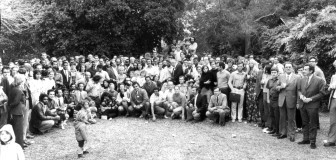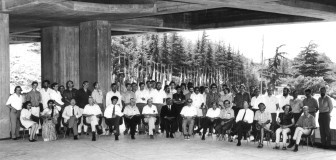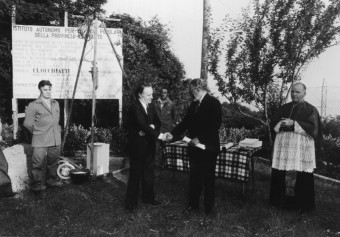Personal tools
News from ICTP 109 - Features - That 1970s Centre

From a historical perspective, the 1970s appears to be the Centre's 'quiet' decade. But it was also a time when much of the fundamental work needed to ensure the long-term vitality of ICTP's scientific and administrative activities was carried out.
That 1970s Centre
The 1970s began with the United
Nations Educational, Scientific and Cultural Organization (UNESCO)
joining the International Atomic Energy Agency (IAEA), the Centre's
original UN sponsor, as a full partner in the management of ICTP.
The decade ended with the awarding of the Nobel Prize to Abdus
Salam for his contributions to the theoretical unification of
the electromagnetic and weak forces.
The first event signalled that the Centre's research and training
activities would move beyond their initial focus on high energy,
nuclear and plasma physics (a reflection of IAEA's mandate) to
encompass broader areas of study that fell within UNESCO's responsibilities
to promote the basic sciences.
UNESCO's anticipated arrival had spurred the creation of an ad
hoc committee in 1969. The committee, led by the Dutch physicist
Hendrik B.G. Casimir, research director of Philips Research Laboratories
in the Netherlands, not only commended ICTP for five years of
excellent work but suggested that ICTP expand its activities into
other physics-related areas.
As a result, the 1970s witnessed the launching of courses in computing
as a language of physics (1971); applied mathematics (1972); atomic,
molecular and laser physics (1973); the physics of ocean and atmosphere
(1975); science teaching (1976); non-conventional energies (1977);
and mathematical economics (1978).

International Symposium on the Development of the Physicist's Conception of Nature in the Twentieth Century, dedicated to P.A.M. Dirac on the occasion of his 70th birthday, 18-25 September 1972
In 1977, another ad hoc committee, led by Léon Van
Hove, research director general of the European Organisation for
Nuclear Research (CERN), in Geneva, Switzerland, urged that biophysics
and earth sciences be added to the Centre's curriculum and that
computing facilities be made readily available. Both recommendations
would turn into reality by the early 1980s.
The second event, which took place in Sweden in December 1979,
marked a dramatic turning point in the history of the Centre.
The acclaim that accompanied the awarding of the Nobel Prize to
Salam in 1979 made both him and the institution that he founded
world famous. That notoriety, in turn, set the stage for a period
of feverish expansion in the 1980s.
While these momentous events provide convenient 'bookends' for
the 1970s, the decade itself is often viewed as a time of consolidation
sandwiched between the dramatic formation of ICTP in the 1960s
and its unprecedented growth in the 1980s.
I remember to this day the remark that Abdus Salam made soon after
we had moved from the Centre's original location in Piazza Oberdan,
in downtown Trieste, to the newly constructed Main Building on
Miramare campus facing the Adriatic Sea.
"Now," he said in a booming voice laced with an English
accent, "we've got to fill this bloody place."
That was the challenge Abdus Salam set for himself as he peered
down the empty corridors of the Main Building in the early 1970s.
For him and all those involved in the Centre, it was truly intimidating
to think that ICTP had quadrupled in size--physical size, that
is--less than a decade after its birth.

Summer College on Global Analysis and its Applications, 4 July - 25 August 1972
In many ways, Abdus Salam's plaintive call--driven by equal
doses of excitement and anxiety--captured the essence of the decade.
In effect, that was what the 1970s were about: filling space both
physically and, more importantly, with an active scientific agenda
worthy of ICTP's lofty goals.
The number of scientists visiting the Centre throughout the 1970s
was small, averaging about 1000 each year. Accordingly, the number
of permanent staff and scientists was extremely small but it was
complemented by strong interaction with the physicists at Trieste
University who were effectively acting as the scientific staff
of the Centre. In addition, many scientists working for the Centre
were employed as professors elsewhere and usually came to Trieste
for several weeks or months each year on a temporary basis.
During the decade, the Centre served as a focal point for such
research topics as the standard model, and the interaction of
particles and nuclei.
It is also important to note that the pace of the Centre's activities
was far different than it is today.
ICTP research and training activities tended to be fewer in number
and longer in length. Take, for example, the Workshop on Solid
State Physics in 1972. It began on 15 April and ended on 31 August,
attracting 64 scientists from 21 countries. Or, the Autumn Course
on the Applications of Analysis to Mechanics in 1976, which began
on 22 September and continued until 3 December. It had 80 participants
from 30 countries. In fact, the scientific calendar in 1972 consisted
of just 5 activities; the calendar in 1976, 14.

Topical Meeting on Gravitation and Field Theory, 13-16 July 1971
All of this meant that for large stretches of time, especially
in winter, the Centre was a quiet--indeed an empty--place which,
in Salam's words, needed to be "filled up."
Yet the limited number of activities held at the Centre each year
did not mean that ICTP was a cold and unfriendly place. The corridors
may have at times been empty but the place was imbued with a warm
inviting atmosphere that was to become a hallmark of the institution
and one of its most attractive characteristics. ICTP, thanks largely
to the dedication of its staff, quickly evolved into a 'people
friendly' scientific institution.
In fact, the small number of activities and the intense interaction
that took place at the workshops and courses nurtured a strong
sense of belonging for those who were involved. Add to all this
the prevailing belief that we were building a unique and valuable
institution, as well as Abdus Salam's unwavering enthusiastic
commitment to the cause, and it is not difficult to see why many
of us felt we were a family. Scientists often spoke of the Centre
as their 'second home.' I think it is fair to say that many staff
felt the same way.
And because ICTP had no guesthouses--the Galileo Guesthouse did
not open its doors until 1982 and the Adriatico Guesthouse until
1985--all of our lecturers and participants had to be housed in
apartments and rooms in downtown Trieste. This meant that visitors
to the Centre enjoyed continuous interaction with the citizens
of Trieste in ways that enabled our guests to learn firsthand
about the city and for Triestini to learn, often in a personal
way, about the unique contributions that the Centre was making
to the life of their city. Science was our main business, but
cross-cultural dialogue was an added benefit not just in the Centre
itself but in the community beyond.

Galileo Guesthouse cornerstone laying ceremony, 28 June 1977
The Italian government's contributions to the Centre averaged
about US$350,000 a year throughout the 1970s. To supplement this
funding, the Centre successfully sought and acquired programmatic
funding from a variety of external sources. The United Nations
Development Programme (UNDP), for example, provided funds from
1971 to 1978 for activities in solid state physics and mathematics,
and the Swedish International Development Authority (SIDA) partially
funded the Associateship Programme from 1969 as did the Ford Foundation
from 1967 to 1973.
These external sources of funding enabled the Centre to both deepen
and broaden the range of its activities at a time when observers
were watching closely to see if the nascent institution would
be able to fulfill its promise. The financial security that ICTP
enjoys today, marked by the ongoing generosity of the Italian
government, which accounts for more than 80 percent of the Centre's
budget, is due in no small measure to ICTP's ability to develop
a strong and enduring roster of research and training activities
during the 1970s and to devise effective mechanisms for ensuring
that scientists were well cared for during their stay in Trieste.
That's the kind of 'quiet' stuff that made the 1970s so critical
to ICTP's long-term success. In retrospect, the 1970s weren't
that quiet at all.
Luciano Bertocchi
ICTP's Deputy Director, 1983-1997
Acting Director, 1994-1995